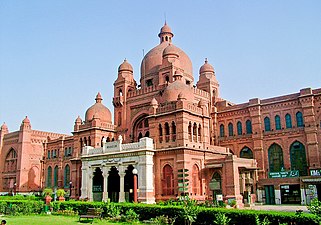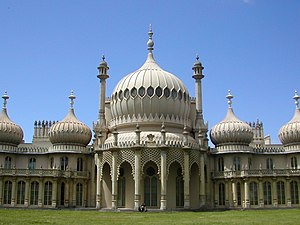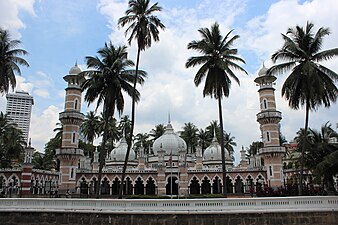Indo-Saracenic architecture
Indo-Saracenic Revival (also known as Indo-Gothic, Mughal-Gothic, Neo-Mughal, Hindoo style) was an architectural style mostly used by British architects in India in the later 19th century, especially in public and government buildings in the British Raj, and the palaces of rulers of the princely states. It drew stylistic and decorative elements from native Indo-Islamic architecture, especially Mughal architecture, which the British regarded as the classic Indian style, and, less often, Hindu temple architecture. The basic layout and structure of the buildings tended to be close to that used in contemporary buildings in other styles, such as Gothic revival and Neo-Classical, with specific Indian features and decoration added. Saracen was a term used in the Middle Ages in Europe for the Arabic-speaking Muslim people of the Middle East and North Africa.
The style drew from western depictions of Indian buildings from about 1795, such as those by William Hodges and the Daniell duo (William Daniell and his uncle Thomas Daniell). The first Indo-Saracenic building is said to be the Chepauk Palace, completed in 1768, in present-day Chennai (Madras). Chennai, Mumbai, and Kolkata, as the main centres of the Raj administration, possess many buildings in the style, although Kolkata was also a bastion of European Neo-classical style. Most major buildings are now classified under the Heritage buildings category as laid down by the Archaeological Survey of India (ASI), and protected.
The wider European version, also popular in the Americas, is Moorish Revival architecture, which tends to use specific South Asian features less, and instead those characteristic of the Arabic-speaking countries, especially Islamic Spain. But architects often mixed Islamic and European elements from various areas and periods with boldness.
Characteristics
Indo-Saracenic designs were introduced by the British colonial government, incorporating the aesthetic sensibilities of continental Europeans and Americans, whose architects came to astutely incorporate telling indigenous "Asian Exoticism" elements, whilst implementing their own engineering innovations supporting such elaborate construction, both in India and abroad, evidence for which can be found to this day in public, private and government owned buildings. Public and Government buildings were often rendered on an intentionally grand scale, reflecting and promoting a notion of an unassailable and invincible British Empire.
Again, structures of this design sort, particularly those built in India and England, were built in conformance to advanced British structural engineering standards of the 1800s, which came to include infrastructures composed of iron, steel and poured concrete (the innovation of reinforced cement and pre-cast cement elements, set with iron and/or steel rods, developed much later); the same can be said for like structures built elsewhere, making use of the same design vocabulary, by local architects, that would come to be constructed in continental Europe and the Americas: Indo-Saracenic’s popularity flourished for a span of some 30-years.
Notable, too, is that the British, in fact Europeans generally, had long nurtured a taste for the aesthetic exuberance of such “Asian exoticism” design, as displayed in innovative Indo-Saracenic style and also in their taste for Chinoiserie and Japanned. Supported by the imagination of skilled artisans of various disciplines, exoticism promulgated itself across a broad demographic of British, European and Americas’ citizenry, Adaptation of such design innovations spilled over into and determined the aesthetic direction of major architectural projects, expressing themselves in the Baroque, Regency and design periods beyond.
Today, that spread of elaborate Asian exoticism design fulfillment remains evidenced in many residential and governmental edifices wrought of the masterpiece initiatives of the 16th, 17th and 18th centuries; much had initially been contributed by the stupendously rich and indulgent sea-merchant Venetian Empire, whose existence spanned nearly a millennium, and whose Gothic architecture came to incorporate a plethora of Asian exoticism elements, such as the Moorish Arch in its windows, related to the latter "harem window"
Generally, the insatiable craze for Asian exoticism relished those earlier periods, testamentary in their parallel Chinoiserie expression, likewise, ushered in this latter colonial British fascination with the luxuriant exoticism found in the indigenous Indian design milieu, whose characteristics includes the following vocabulary list of design elements and motifs (often paralleling and expanding upon the already ornateness of the earlier Venetian’s unique Gothic-Moorish, also known as Venetian Gothic architecture ad-mixture):
- onion (bulbous) domes
- Chhajja, overhanging eaves, often supported by conspicuous brackets
- pointed arches, cusped arches, or scalloped arches
- horseshoe arches, in fact characteristic of Islamic Spain or North Africa, but often used
- contrasting colours of voussoirs round an arch, especially red and white; another feature more typical of North Africa and Spain
- curved roofs in Bengali styles such as char-chala
- domed chhatri kiosks on the roofline
- pinnacles
- towers or minarets
- harem windows
- open pavilions or pavilions with Bangala roofs
- jalis or openwork screens
- Mashrabiya or jharokha-style screened windows
Chief proponents of this style of architecture were these: Robert Fellowes Chisholm, Charles Mant, Henry Irwin, William Emerson, George Wittet and Frederick Stevens, along with numerous other skilled professionals and artisans throughout Europe and the Americas.

Structures built in Indo-Saracenic style in India and in certain nearby countries were predominantly grand public edifices, such as clock towers and courthouses. Likewise, civic as well as municipal and governmental colleges along with town halls counted this style among its top-ranked and most-prized structures to this day; ironically, in Britain itself, for example, King George IV's Royal Pavilion at Brighton, (which twice in its lifetime has been threatened with being torn-down, denigrated by some as a “carnival sideshow”, and dismissed by others as “an architectural folly of inferior design”, no less) and elsewhere, these rare and often diminutive (though sometimes, as mentioned, of grand-scale), residential structures that exhibit this colonial style are highly valuable and prized by the communities in which they exist as being somehow "magical" in appearance.
Typically, in India, villages, towns and cities of some means would lavish significant sums on construction of such "indigenous ethnic architecture" when plans were drawn up for construction of the local railway stations, museums and art galleries.
The cost involved in the construction of buildings of this style was high, including all their inherent customization, ornament and minutia decoration, the artisans' ingenuous skills (stone and wood carving, as well as the exquisite lapidary/inlaid work) and usual accessibility to requisite raw materials, hence the style was executed only on buildings of a grand scale. However the occasional residential structure of this sort, (its being built in part or whole with Indo-Saracenic design elements/motifs) did appear quite often, and such buildings have grown ever more valuable and highly prized by local and foreign populations for their exuberant beauty today.
Either evidenced in a property’s primary unit or any of its outbuildings, such estate-caliber residential properties lucky enough to boost the presence of an Indo-Saracenic structure, are still to be seen, generally, where in instances urban sprawl has not yet overcome them; often they are to be found in exclusive neighborhoods' (or surrounded, as cherished survivors, by enormous sky-scarpers, in more recently claimed urbanized areas throughout this “techno” driven, socio-economic revolutionary era marking India’s recent decade’s history), and are often locally referred to as "mini-palaces". Usually, their form-factors are these: townhouse, wings and/or porticoes. Additionally, more often seen are the diminutive renditions of the Indo-Saracenic style, built originally for lesser budgets, finding their nonetheless romantic expression in the occasional and serenely beautiful garden pavilion outbuildings, throughout the world, especially, in India and England.
In British Malaya

Despite having relatively little relationship to the traditional local style, Indo-Saracenic was exported to British Malaya (present day Peninsular Malaysia) by British engineers and architects influenced by Indo-Saracenic stylings in British India. During the design of government offices for the Selangor state government in Kuala Lumpur in the late 19th century, C. E. Spooner, then State Engineer of the Public Works Department, favoured a "Mahometan style" over a neoclassical one to reflect Islamic mores in the region, instructing architect A.C. Norman, with further assistance by R. A. J. Bidwell, to redesign the building.[1] Having previously served in northern India, Norman and Bidwell incorporated various elements of Indo-Saracenic architecture into the building. Upon completion in 1897, the government offices (now known as the Sultan Abdul Samad Building), which would later house the administration of the Federated Malay States and the various post-independence governmental departments, became the one of the earliest examples of Indo-Saracenic architecture in Malaya.[1] The building's construction inspired additional civic buildings in the vicinity to be built in a similar style, while a handful of commercial buildings in Malaya have also been known to adopt some of the style's elements. Arthur Benison Hubback became the leading architect in the style for the early 20th century.
The style was also favoured as one of several adopted by British architects for Malayan mosques as they did not feel the need to adhere accurately to the cultural heritage and the traditional culture of the Malays, who remain prominent in Malayan society and are Muslims but lacked the means to design buildings of grand scales; both the Jamek Mosque and Ubudiah Mosque by Arthur Benison Hubback are examples of mosques that resulted from this combination.[2]
While its popularity was limited to the 1890s to the 1910s, the style has inspired designs for newer governments buildings from the late-20th century and 21st century, such as Perdana Putra and the Palace of Justice in Putrajaya.
Indian context
Confluence of different architectural styles had been attempted before during the mainly Turkic, Delhi Sultanate and Mughal periods. Turkic and Mughal conquest in the Indian subcontinent, introduced new concepts in the already rich architecture of India. The prevailing style of architecture was trabeate, employing pillars, beams and lintels. The Turkic invaders brought in the arcuate style of construction, with its arches and beams, which flourished under Mughal and Taluqdar patronage and by incorporating elements of Indian architecture, especially Rajasthani temple architecture
Local influences also lead to different 'orders' of the Indo-Islamic style. After the disintegration of the Turkic Delhi Sultanate, rulers of individual states established their own rule and hence their own architectural styles, which was heavily influenced by local styles. Examples of these are the 'Bengal' and the 'Gujarat' schools. Motifs such as chhajja (A sunshade or eave laid on cantilever brackets fixed into and projecting from the walls), corbel brackets with richly carved pendentive decorations (described as stalactite pedentives), balconies, kiosks or chhatris and minars (tall towers) were characteristic of the Mughal architecture style, which was to become a lasting legacy of the nearly four hundred years of the Mughal rule.
Mughal style

The Mughal style was conceived by Akbar the Great, the third Mughal emperor and also the architect of the Mughal empire. This "Akbari" Style was an amalgam of earlier Timurid, Persian and indigenous Indian styles. This style was further consolidated by his grandson and fellow architecture enthusiast, Shah Jahan. Some of the significant architectural legacies of the Mughals are Humayun's Tomb, the Taj Mahal, the Forts of Agra and Lahore, the city of Fatehpur Sikri, Akbar's Tomb.
Decline and revival

Shah Jahan was succeeded by his son, Aurangzeb, who had no soft spot for art and architecture. As a result, Mughal architecture suffered, with all artisans migrating to work under the patronage of local rulers. With no major architectural projects undertaken, the Mughal style rapidly declined. This decline was evident in buildings such as Bibi Ka Maqbara, built by Azam Shah, son of Aurangzeb. However, local rulers embraced the style, as they had emulated it during the respective reigns of Jahangir and Shah Jahan.[3] The last architectural marvel produced during this waning period of Mughal rule was Safdarjung's Tomb, mausoleum to the second Nawab of Awadh.
By the early 19th century, the British had made themselves the virtual masters of the Indian Subcontinent. In 1803, their control was further strengthened with the defeat of the Marathas under Daulatrao Scindia. They legitimized their rule by taking the then weak Mughal Emperor, Shah Alam II under their protection, and ruling through him. However, their power was yet again challenged when in 1857, the Indian soldiers in their employ, together with rebellious princes lashed out in open revolt, which came to be known as the Revolt of 1857. However, this uprising was doomed from the start, and was crushed by the British with ferocity, marking the end of the Mughal Empire.[4] At first, the new British regime lacked respect for Mughal buildings, demolishing a significant number of buildings in the Red Fort, latterly the main imperial Mughal residence, to build barracks. There was even a proposal to demolish the Taj Mahal and sell the materials. Over the following decades, attitudes changed and the British established the Archaeological Survey of India in 1861 and restored several important monuments.
To usher in a new era, the British "Raj", a new architectural tradition was sought, marrying the existing styles of India with imported styles from the West, such as Gothic (with its sub styles of French Gothic, Venetian-Moorish etc.), Neoclassical and, later, new styles such as Art Deco. By doing this they kept elements of British and European architecture, while adding Indian characteristics; this, coupled with the British allowing some regional Indian princes to stay in power, made their presence more "palatable" for the Indians. The British tried to encapsulate South Asia's past within their own buildings and so represent Britain's Raj as legitimate, while at the same time constructing a modern network of railways, colleges, and law courts.
The main building of Mayo College, completed in 1885, is in the Indo-saracenic style, the architect being Maj Mant. Examples in Chennai include the Victoria Public Hall, Madras High Court, Senate House of the University of Madras, and Chennai Central station.
The building of New Dehli as the new imperial capital, which mostly took place between 1918 and 1931, led by Sir Edwin Lutyens, brought the last flowering of the style, using a deeper understanding of Indian architecture. The Rashtrapati Bhavan (Viceroy's, then President's Palace) uses elements from ancient Indian Buddhist architecture as well as those from later periods. This can be seen in the capitals of the columns and the screen around the drum below the main dome, drawing on the railings placed round ancient stupas.
Examples
Bangladesh
-
Curzon Hall in Dhaka
India
-
Mumbai GPO, reminiscent of the Gol Gumbaz
-
Secretariat Building, Govt of India, New Delhi
-
Secretariat Building, New Delhi, headquarters of the govt of India
Pakistan
-
Sadiq Dane High School, Bahawalpur
-
University of the Punjab, Lahore
-
Patiala Block of King Edward Medical University, Lahore
-
Noor Mahal, Bahawalpur
-
Karachi Chamber of Commerce Building
-
National Academy of Performing Arts, Karachi
-
Aitchison College, Lahore
-
Government College University, Lahore
United Kingdom
-
Sezincote House, 1805
-
Royal Pavilion in Brighton, 1815-23
-
Western Pavilion in Brighton, 1828, designed by Amon Henry Wilds as his own home
-
Elephant Tea Rooms, Sunderland, 1877
-
Sassoon Mausoleum, now a chic Brighton supper club, 1892
Malaysia
-
National Textile Museum in Kuala Lumpur.
-
The Old High Court Building in Kuala Lumpur
-
Jamek Mosque in Kuala Lumpur
-
Railway Administration Building, Kuala Lumpur
-
Kellie's Castle, Batu Gajah, Perak
Sri Lanka
-
Jami Ul-Alfar Mosque in Colombo
-
Jaffna Public Library in Jaffna
France
-
Palais du Bardo, parc Montsouris, Paris
References
- ^ a b Gullick, John Michael (1998). "The British 'Raj' style ", The Encyclopedia of Malaysia (Architecture), p. 82–83.
- ^ Mizan Hashim, David (1998). "Indian and Mogul influences on Mosques", The Encyclopedia of Malaysia (Architecture), p. 84–85.
- ^ The rulers of Rajputana would construct their palaces in Mughal style to impress their overlord, the Great Mughal. Examples of such structures are the Amber Fort near the city of Jaipur, the Orchha palace in Madhya Pradesh and most of the Mehrangarh Fort in Jodhpur
- ^ The last Mughal Emperor, Bahadur Shah II became a pawn of the mutineers and was arrested and exiled for treason































































